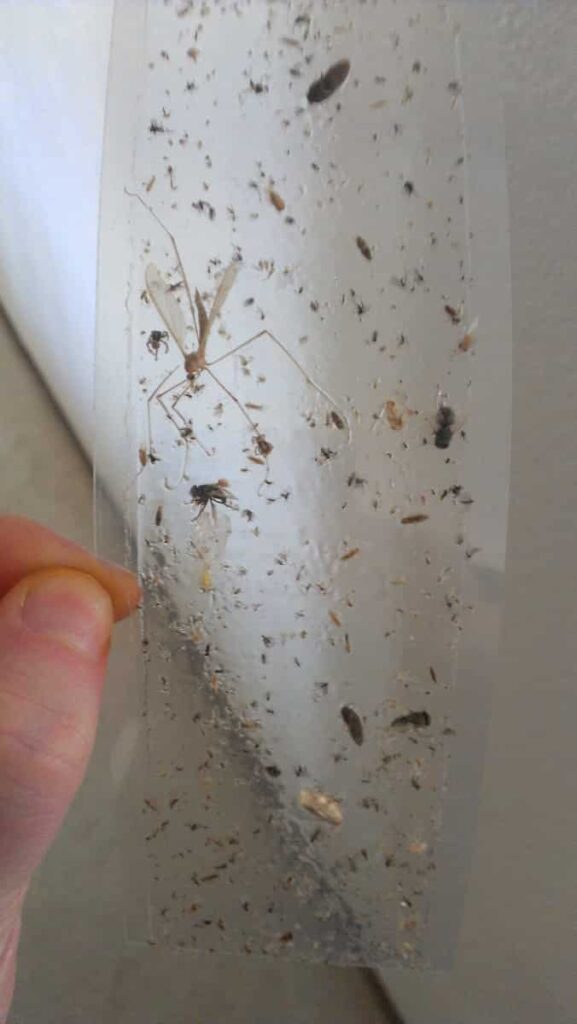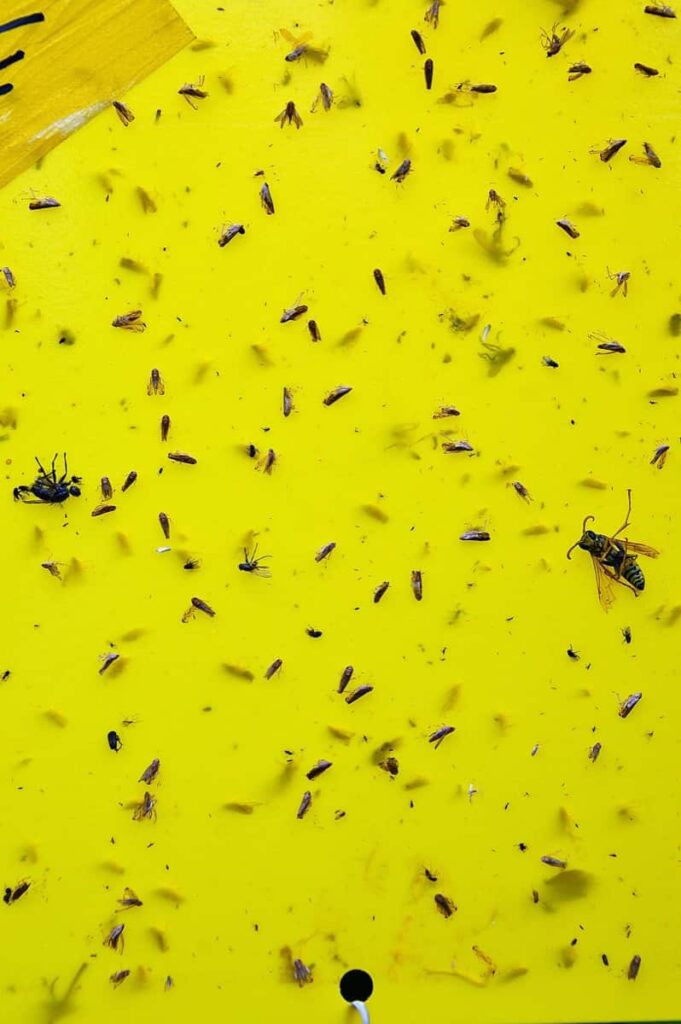Pests in the garden can be a real problem. They eat and infect your plants and disturb you and your guests while you try to enjoy the outdoors. There are many solutions for dealing with unwanted pests, and each has advantages and disadvantages. A sticky tarp is a strategy for insects. Sticky traps are very valuable to growers. They are used for mainly two things: trapping or monitoring. Trapping in numbers can effectively reduce certain pests, such as whiteflies and fungus gnats, by trapping airborne adults.
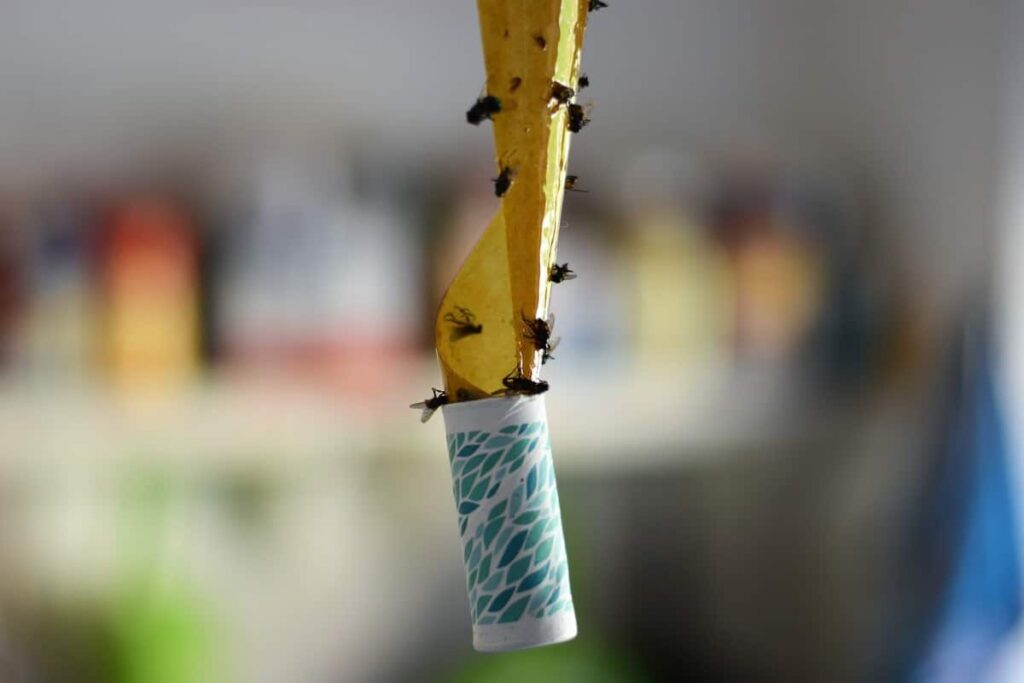
How to use sticky traps for pest control
What is a sticky trap?
Sticky trap pest control means using a glue-based trap to capture and immobilize pests. These types of traps are usually made of cardboard with a layer of sticky glue. The card can also be folded into a tent shape or laid flat. The tent cover protects the adhesive surface from dust and other materials. Sticky traps are glue-based traps frequently used in pest control to capture and monitor insects and other pests.
Typically, sticky traps consist of a layer of adhesive applied to a piece of cardboard that is folded into the tent structure to protect the adhesive surface. Sticky traps have no pesticides, although some may be colored with scents designed to attract insects. Sticky traps are less effective at trapping bed bugs and flying insects.
How does blue sticky trap work?
Sticky traps are essential for detecting and partially eliminating many species of flying insects in greenhouses. Sticky traps make it possible to detect pests early and use biological measures to combat them. This prevents the unnecessary use of chemicals. Additionally, continuous counting of captured insects on sticky traps reveals when insects are present in the greenhouse, how fast their populations are growing, and when their populations are likely to peak. In this way, the farmer is much better prepared for potential risks.
Where can I purchase sticky traps?
Sticky traps can be purchased from many hardware stores or online outlets. Another commercial source could be your local pest control company or a pest control store.
In case you missed it: Moringa Pests, Diseases, and Control Methods (Drumstick)
The main purpose of using sticky traps for pest control
The main purpose of sticky traps, which you can find in most plant nurseries, is to monitor adult flying insects. As they are non-selective, a range of pests such as aphids, thrips, fruit flies, leaf miners, and whiteflies are captured. Sticky traps can only be sold or used if they cannot trap animals (birds, micro-bats, rodents, etc.). In addition, all sticky traps sold must have a cage, barrier, cover, or other design features that prevent an animal from coming into contact with the adhesive surface.
These traps are easy to maintain, low cost, suitable for different habitats, and easy to remove for agricultural practices. This allows for the sampling of many locations over a large area. The sticky traps are monitored weekly during the growing season. Adults of the species of interest collected on sticky traps are identified in the field using a pictorial key, counted, recorded on sampling sheets, and then removed from the card.
Traps are changed every two weeks. New species for sticky trap collection are preserved in ethanol for later identification and inclusion in future predator counts (e.g., new species records, invasive species). Data and ancillary information are entered into statistical spreadsheets for analysis and archiving.
Different sticky trap varieties for pest control
- Light traps – Light traps mean, with or without ultraviolet light, attract certain insects. Light sources may include fluorescent lamps, mercury vapor lamps, black lights, or light-emitting diodes.
- Adhesive traps – Adhesive traps can be simple flat panels or closed structures, often stained, that trap insects with an adhesive substance.
- Flying insect traps – These traps are used to catch flying or airborne insects. Flight interception traps are transparent structures that trap flying insects and prevent them from gathering. Barrier traps have a simple vertical sheet or wall that guides insects into collection containers.
- Terrestrial arthropod traps – These traps are used for ground baits and flightless arthropods like carabid beetles and spiders. It consists of a bucket or container buried in soil or another substrate so that its lip drains from the substrate.
Sticky trap application for controlling pests
Target crops – Cotton, Cereals, Pulses, Oilseeds, Fruits, Vegetables, Spices, Sugarcane, Potatoes, and ornamental crops.
Method of Application – Start using traps early in the crop, before pests affect the crop. Use 24-40 sticky traps per acre. If adult insects are present on the crop, they should be prevented from tapping the plants. Once they fly out, they will be caught by traps, especially whiteflies. Hang the traps just above the plants (10 to 14 cm). Monitor traps weekly and checks insect density. Then, take appropriate measures to control pests.
Advantages – Ideal for early detection of pests. Eco-friendly, economical, and easy to install, low maintenance. Suitable for organic farming.
In case you missed it: Fenugreek Pests And Diseases – Control Measures
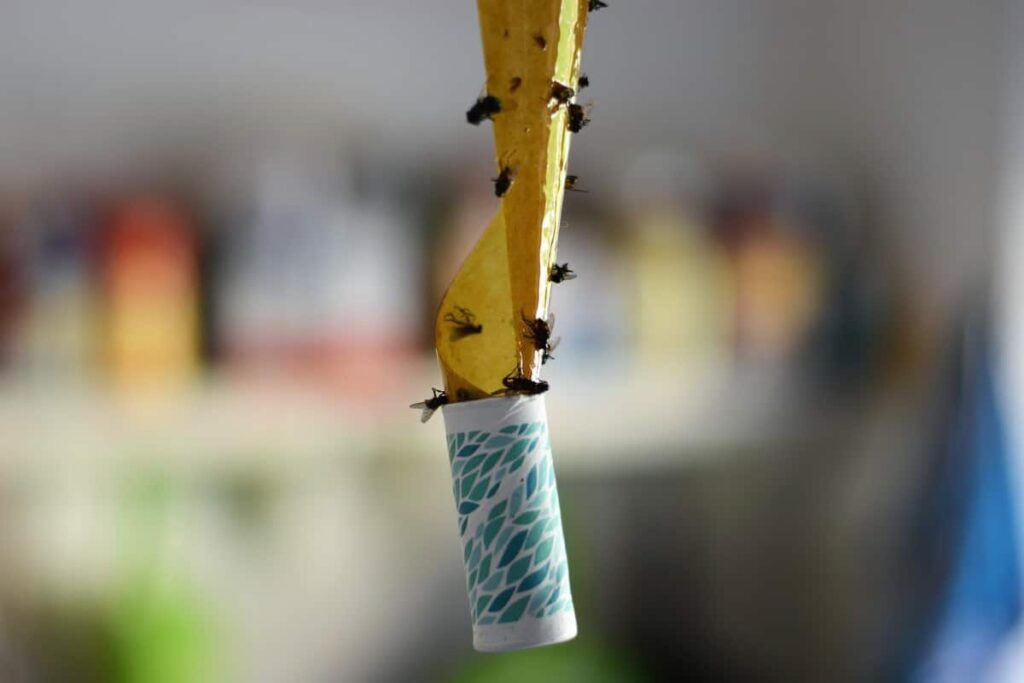
Types of sticky traps based on colors
Sticky traps come in many colors, as different species of insects attract different colors.
- Yellow sticky traps – Yellow sticky traps are the most popular sticky traps. Many pests are attracted to the color yellow, which is why yellow sticky traps are so effective against fungus gnats and whiteflies, for example. You can buy yellow sticky traps for insects in our online shop.
- Blue sticky traps – Blue sticky traps are another type of sticky trap. Blue Sticky Traps are mainly used to control or monitor thrips.
- White sticky traps – White sticky traps specifically target California flower thrips, apple sawflies, and plum sawflies. White glue traps can also monitor and capture the raspberry beetle.
- Red sticky traps – Red sticky traps are used for the pear blight beetle. This pest is especially common in orchards and vineyards. It attacks Apple, Cherry, and Pear trees by boring into the wood and laying eggs.
- Orange sticky traps – Orange sticky traps are used for carrot flies. These insects not only attack carrots but can also damage Celery and Parsnips.
When to use sticky traps?
A sticky trap is commonly used to reduce aphid, whitefly, and thrips populations in a greenhouse or your home. These traps can monitor pest populations to see if other pest control strategies are working or to find out where your biggest pest problems are.
However, in terms of outdoor garden pest management, sticky traps create problems for wildlife, so other pest control strategies should be used instead. Making a garden more attractive to beneficial insects, for example, can help keep nuisance insect populations down, as many feeds on them. Ladybugs, for example, love to snack on aphids.
Will sticky traps control pests?
Sticky traps best used is to detect pests and monitor changes in pest abundance. When multiple traps are located in a room, they can also help pinpoint the source of a pest problem. However, glue traps for controlling vertebrate pests (such as mice or rats) can provide effective control when used by an experienced pest control professional.
Best place to place sticky traps
Most insects and rodents prefer to travel in dark areas and along edges. Therefore, the best place for the sticky card is outside, in direct contact with the wall. The two open ends of the trap must run parallel to the wall to facilitate insect entry. The number of traps you place will be limited by how many locations you have to deploy and how regularly you want to check the traps. You’ll generally want to place sticky traps at least 5-10 feet apart in areas where pests are likely to travel.
For example, behind stoves and refrigerators, cupboards, and under sinks are good places to trap cockroaches with sticky traps. Garages and interior walls in storage and living areas are good places to keep sticky cards for brown recluses and other spiders. Outdoor pest entry points are good places for sticky cards to trap outdoor cockroaches, beetles, crickets, scorpions, and other miscellaneous reptiles. To monitor for potential biting mites, place sticky cards where bites are visible near attic doors or fireplaces where birds may nest.
The best place to set your sticky trap is under your plant. This allows the trap to catch pests as they approach, if they fall from the plant, or if they are attracted to the color or scent and land on the trap. If you have more than one plant, place your trap between them. If possible, spread your traps wider so they cover more ground and are more likely to catch more insects. You can even hang them above or in front of your plants to catch flying insects.
In case you missed it: Vegetable Diseases – Types, Control In India
Use blue sticky traps for pest control
Blue sticky traps are non-toxic to control and monitor thrips and leafminers. They attract a unique blue color and stick to the trap with non-drying glue. Many insects are difficult to control with pesticides. However, the blue trap has some significant advantages. While more attractive to blue thrips, it is less attractive to other species. This increases the specificity of the traps and avoids the complications of attracting non-target and especially beneficial insects, which need to be protected.
Blue traps can be conveniently used in glass houses, where beneficial insects are released. Some bugs are still caught, but this is likely due to random contact. As an integral part of an integrated pest management program, they can be used in commercial crops, greenhouses, homes, orchards, flower and vegetable gardens, and anywhere pests are a problem.
Application of blue sticky traps
| Pest attracted | ThripsLeaf miners |
| Crops | Cotton Paddy Vegetables Flowers |
| Benefits | Highly effective Non-toxic Easy to use |
How to make yellow sticky traps for insects
Yellow sticky traps were developed to monitor the pest population in the field. It attracts flies and sticks them with yellow glue, which is monitored regularly. A sudden increase in trapped pest populations is an alarm bell for adopting pest control measures in the field. Nowadays, yellow sticky trapping is a good method to effectively control the population of whiteflies, thrips, winged aphids, and leaf miners in greenhouses.
Yellow sticky traps come in various shapes (rectangular, circular, or tape-shaped) and sizes, painted with yellow oil paint and coated with glue, white grease, or Vaseline. Most insects are attracted to yellow or bright yellow. Insects become trapped in the glue when they come in contact with the yellow trap, which is changed periodically. Thus, it controls the population of flies, thrips, aphids, and leaf miners. Depending on the size, a trap is effective in an area of 250 to 1000 square feet.
Use yellow sticky traps to monitor most insects. (Includes whiteflies, fungus gnats, beach flies, thrips, winged aphids, leaf miners, scales, and many others). But be aware that they can unknowingly harbor parasitic wasps, midges, and beetles. Use with caution. Reduce the execution period if needed, and be consistent.
Application of yellow sticky traps
| Pest attracted | Whiteflies, aphids, leaf miners, fungus gnats, beach flies, thrips, winged aphids |
| Crops | Cotton, mustard, vegetable, and flowers |
| Benefits | Highly effective, non-toxic, and easy to use. |
Disadvantages of Yellow Sticky traps
- Bright yellow can stand out from your beautiful plants and distract.
- The use of yellow sticky traps in open fields is limited.
In case you missed it: Ginger Diseases, Pests, Symptoms, And Control
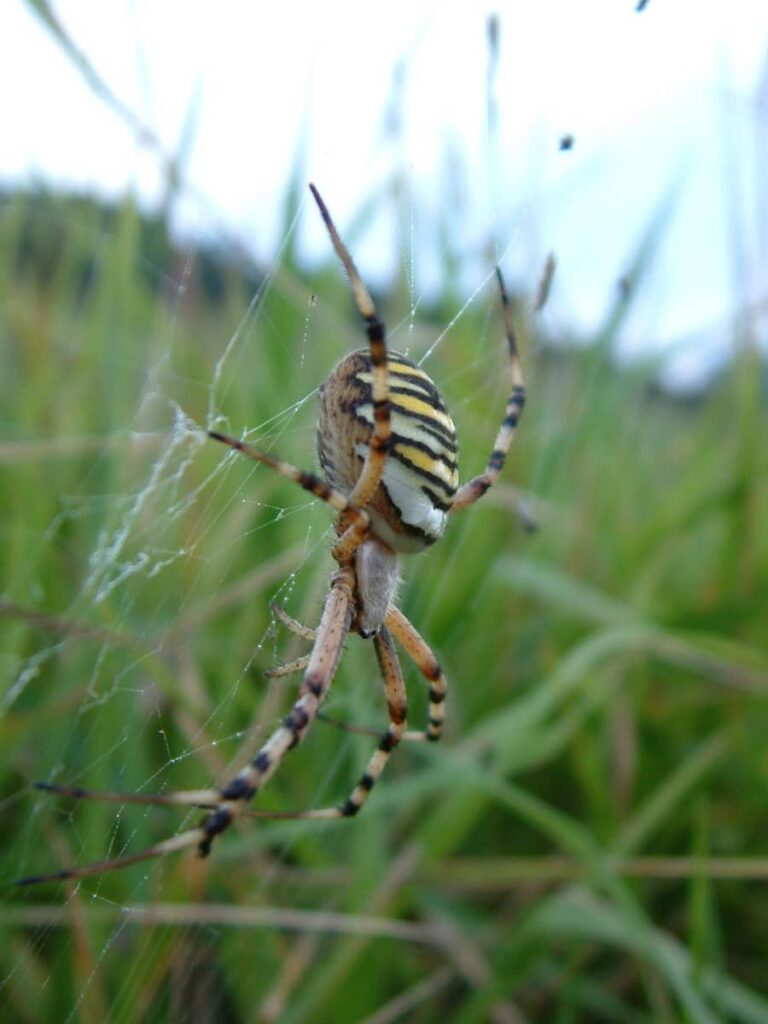
How to make sticky traps for insect control?
Generally, sticky traps are only used to monitor pest infestations and not as a direct control method. Traps only attract adult insects, but the larvae living in the soil usually do the real damage. In addition, some bugs don’t fall prey to the trap, so they can still reproduce. Even so, it makes sense to use sticky insect traps because they can help detect infestations early and allow you to act quickly to take steps to combat the problem.
Because they also allow you to detect infestations and monitor pest numbers easily, traps also help gauge your control method’s success. Some common pests are difficult to monitor. They can be very small, especially when immature, or they may escape detection, living in nooks and crannies on stems and leaves. Some species are green and difficult to see against the foliage. Colored sticky traps can help detect the presence of pests that might otherwise go undetected until they become a problem.
The good news is that insects are generally seasonal, and colored sticky traps can help you predict when the number of flying insects increases or decreases. By monitoring your sticky traps and improving your knowledge of when to expect seasonal visitors, you can decide to employ management strategies before insect feeding damage becomes too great. The term beneficial insects refer to predatory species (also called natural enemies), which attack and feed on plant pests, and include parasitic wasps, hoverflies, and ladybird beetles.
Hanging sticky bug traps
- Catch pesky bugs: Trap mosquitoes, gnats, flies, houseflies, nat, lantern fly, and many other pesky flying insects with this disposable yellow fly sticky trap.
- Great outdoors: Perfect for porches, garages, patios, gardens, stables, lawns, chicken coops, and any popular hotbed to keep flying insects at bay.
Can you reuse traps?
Most of the time, yes, you can reuse your trap. Just put them together, wash them, reapply the sticky substance, and put them back out. However, you may want to use an old rag or sponge that will not be reused to clean them rather than wash them in the sink if any insect traps are left over.
Depending on what you used as the base of your trap, you may not reuse them, or you may only be able to reuse them a limited number of times. For example, a paint sample card or another similar piece of yellow card stock may not be able to withstand multiple uses. This is true if they have been exposed to harsh weather. In this case, your best option is to dispose of the trap and create a new one.
Sticky bug traps are a great method to reduce the number of pests in your garden, and they’re super easy to make. Now that you know this simple process, you can make as many traps as you need to protect your plants. As long as you have something yellow and sticky, you can make any size or shape of sticky bug trap for houseplants or outdoor gardens.
In case you missed it: Okra Pests, Diseases, Symptoms, And Control Measures
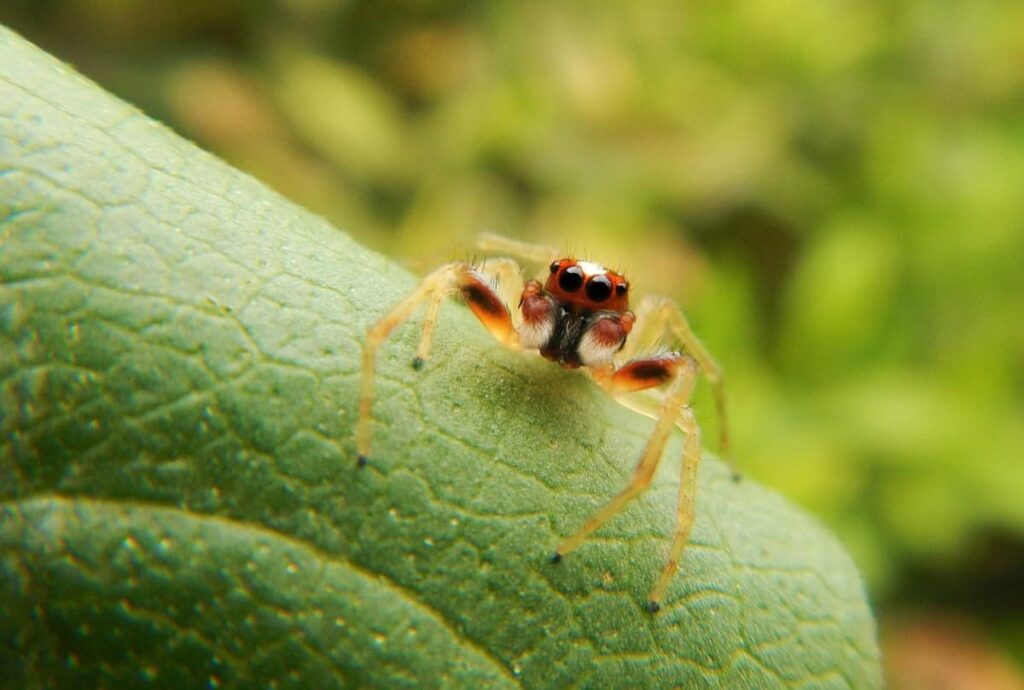
Instructions for usage of sticky traps for pest control
- For tall crops such as Cucumbers, Tomatoes, and Peppers, place the traps just above the plant and adjust as the plant grows.
- For low-canopy crops, support the trap with cane or wire holders and place it no more than 30 cm above the crop.
- Traps should be placed in places with a high risk of pest attack, such as doors, gable ends, and ventilation openings.
- Traps must be removed when significant numbers of flying parasites are caught. For example, it occurs when traps are hung between plants.
Sticky traps usage in pest control
For monitoring purposes, the recommended rate is five traps per 1,000 m². However, use at least one trap per 20 m² or at most one trap per 2 m² if traps contribute to the biological control of pests in so-called hot spots (i.e., mass trapping). Both small and large traps can be used for this purpose.
Conclusion
Sticky traps contain some scent to attract certain insects. Sticky traps allow an inspector to detect pests that are active at night or at other times when people are not around. Sticky traps are useful for the 24/7 monitoring an area for crawling pests and are often used by professionals to increase their ability to detect pests during pest control inspections.
- How to Make Houseplants Bushy: Effective Tips and Ideas
- Innovative Strategies for Boosting Coconut Pollination and Yield
- Pollination Strategies for Maximum Pumpkin Yield
- The Complete Guide to Chicken Fattening: Strategies for Maximum Growth
- Natural Solutions for Tulip Problems: 100% Effective Remedies for Leaf and Bulb-Related Issues
- Revolutionizing Citrus Preservation: Towards a Healthier, Greener Future
- Natural Solutions for Peony Leaf and Flower Problems: 100% Effective Remedies
- Maximizing Profits with Avocado Contract Farming in India: A Comprehensive Guide
- Natural Solutions for Hydrangea Problems: 100% Effective Remedies for Leaf and Flowers
- The Ultimate Guide to Choosing the Perfect Foliage Friend: Bringing Life Indoors
- From Sunlight to Sustainability: 15 Ways to Use Solar Technology in Agriculture
- The Ultimate Guide to Dong Tao Chicken: Exploring from History to Raising
- The Eco-Friendly Makeover: How to Convert Your Unused Swimming Pool into a Fish Pond
- Mastering the Art of Delaware Chicken Farming: Essentials for Healthy Backyard Flocks
- 20 Best Homemade Fertilizers for Money Plant: DIY Recipes and Application Methods
- How to Craft a Comprehensive Free-Range Chicken Farming Business Plan
- Brighten Your Flock: Raising Easter Egger Chickens for Beauty and Bounty
- How to Optimize Your Poultry Egg Farm Business Plan with These Strategies
- Subsidy for Spirulina Cultivation: How Indian Government Schemes Encouraging Spirulina Farmers
- Ultimate Guide to Raising Dominique Chickens: Breeding, Feeding, Egg-Production, and Care
- Mastering the Art of Raising Jersey Giant Chickens: Care, Feeding, and More
- Ultimate Guide to Raising Legbar Chickens: Breeding, Farming Practices, Diet, Egg-Production
- How to Raise Welsummer Chickens: A Comprehensive Guide for Beginners
- How to Protect Indoor Plants in Winter: A Comprehensive Guide
- Ultimate Guide to Grow Bag Gardening: Tips, Tricks, and Planting Ideas for Urban Gardeners
- Guide to Lotus Cultivation: How to Propagate, Plant, Grow, Care, Cost, and Profit
- Agriculture Drone Subsidy Scheme: Government Kisan Subsidy, License, and How to Apply Online
- Ultimate Guide to Raising Araucana Chickens: Breed Profile, Farming Economics, Diet, and Care
- Bringing Hydroponics to Classroom: Importance, Benefits of Learning for School Students
- Ultimate Guide to Raising Polish Chickens: Breed Profile, Farming Economics, Diet, and Care
- Ultimate Guide to Raising Australorp Chickens: Profile, Farming Economics, Egg Production, Diet, and Care
- Silkie Chicken Farming: Raising Practices, Varieties, Egg Production, Diet, and Care
- Sussex Chicken Farming: Raising Practices, Varieties, Egg Production, Diet and Care
- Homemade Feed Formulations for Livestock: Discover Cost-effective Starter to Finisher Feed Recipes
- 20 Best Pig Weight Gain Supplements: Top Swine Weight Gain Formulas
- Ultimate Guide to Elderberry Farming: Propagation, Planting, Yield, Cost, and Profit
